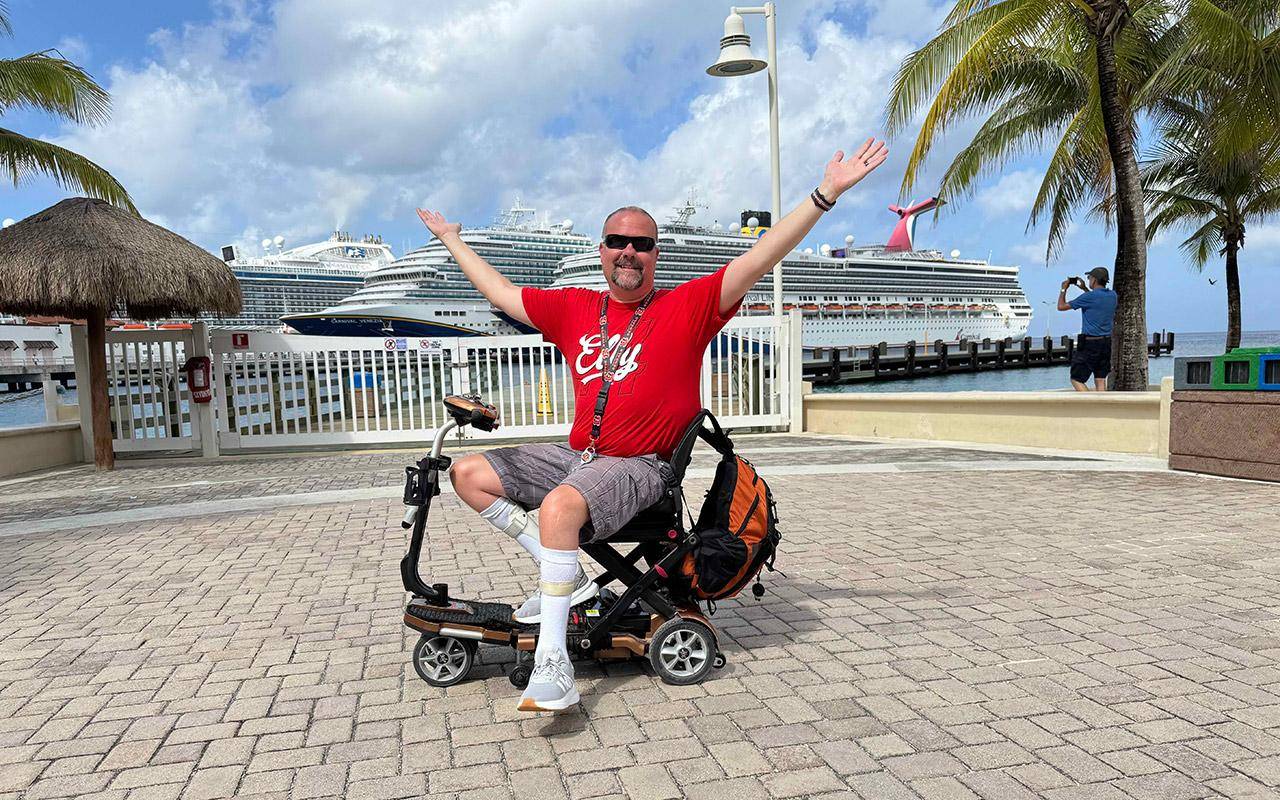As someone born with spina bifida who has cruised from Alaska to the Caribbean with my mobility scooter, I've learned that cruise ships offer remarkable accessibility for travelers who need mobility assistance. While friends often express surprise at how easily I navigate massive ships and enjoy shore excursions, this level of confidence came from experience across multiple cruise lines and destinations. Through four memorable cruises with my lightweight, foldable scooter, I've discovered that modern cruise ships are thoughtfully designed for mobility devices - but proper planning is essential. Whether you're planning your first cruise or you're a seasoned sailor who now needs mobility assistance, I'm passionate about sharing my hard-earned insights to help you confidently prepare for your accessible cruise adventure.
Questions
How Many West Coast Cruises Have You Taken?
Key Points
- Success with mobility scooters on cruises starts with proper planning: choose a lightweight, foldable scooter under 50 pounds, request accessibility information for specific ships directly from the cruise line, book accessible transportation to the port, and consider "Faster to the Fun" or VIP boarding options that many cruise lines offer to smooth the embarkation process.
- Modern cruise ships feature thoughtfully designed accessible accommodations across multiple categories, from Fully Accessible Cabins (FAC) with roll-in showers and turning spaces to Ambulatory Accessible Cabins (AAC) with enhanced safety features like strategically placed grab bars - enabling travelers to choose the level of accessibility that matches their specific needs.
- Cruise lines invest heavily in crew training for accessibility support, with dedicated personnel available to assist during embarkation, tendering, and shore excursions, while onboard staff provide specialized services like plate carrying at buffets and accessibility-focused muster drill accommodations.
- Ships incorporate universal design elements throughout public spaces including push-button doors for restrooms, designated theater seating, pool lifts tested daily, programmable elevators that can be customized for mobility device space needs, and dedicated paths of travel between major venues.
- Shore excursions can be expertly tailored for mobility device users through the cruise line's accessible tour program, with detailed terrain and vehicle information available for each port - from tender-only destinations like Belize to dock-accessible ports throughout Alaska and the Mexican Riviera, allowing for informed decision-making about port activities.
Article Index
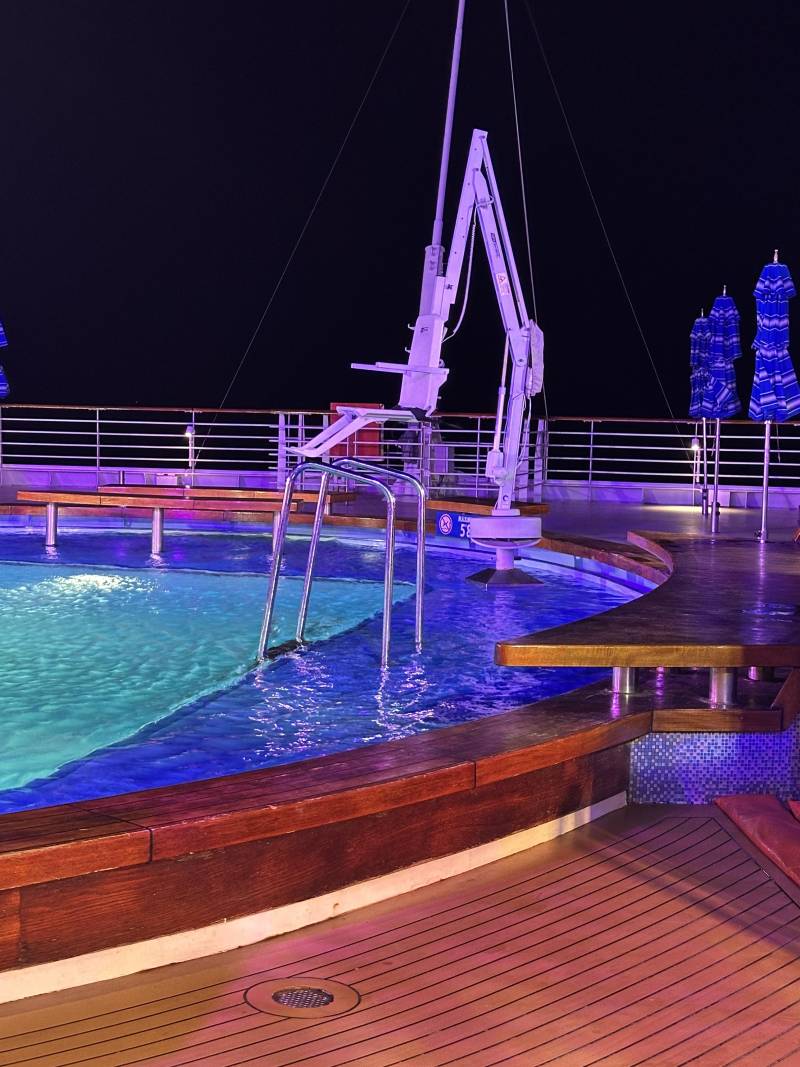
Cruising should be an activity available to everyone. People of all age groups, all races and all abilities should be able to enjoy a wonderful cruise vacation.
I’m fortunate enough as someone with a disability to have been able to enjoy four cruises using my own mobility scooter.
A quick background on my disability. I was born with spina bifida. After many surgeries to keep me reasonably mobile, I am still walking at the age of 51. But my stamina, balance and strength is limited. So for long walking trips (like on vacation, especially a big cruise ship) I bring along my personal mobility scooter.
My ride is an EV Rider Transport decked out in the color bronze. (you can find it here on Amazon as well) It’s been on many vacations, seen many airports and seen several countries throughout my travels. It’s been a god send and the best investment I’ve ever made.
This scooter is awesome as it is lightweight (under 45 lbs.), has a nice battery that holds a good charge, is very maneuverable and best of all folds up like a stroller so it can be gate checked right onto an airplane. Getting through an airport is a breeze.
Now, back to my cruise adventures with this scooter.
Me and my scooter have been on four cruises, including a Royal Caribbean (Allure of the Seas), Princess (Royal Princess) and two Carnivals (Carnival Magic and Carnival Venezia). My latest trip took me on the Carnival Venezia, one of the “newest” ships in the Carnival fleet. I was interested in how elegant the Venezia would be compared to other ships in the fleet.
Spoiler alert: The Venezia is the most beautiful ship I’ve been on.
But we’re not here for me to review the Venezia rather I’m here to share my experience from embarkation to debarkation. While your experience may vary slightly depending on which line you're on and whether your're doing a Mexican Riviera cruise or exploring the Caribbean like my wife and I did this time - your experience will be similar on most cruise ships.
Embarkation
Getting on a cruise ship can be stressful for anyone. It’s crowded and you’re anxious and excited and you just want to get onto the ship and start enjoying that drink package. For someone in a wheelchair or a scooter, embarking is really not that much more challenging. You still have to get through security, but there is a dedicated line for people with scooters. A quick scan of your scooter or wheelchair by security, a wand over your body and you’re free and clear. The scooter doesn’t hinder this process at all.
As regular cruisers on Carnival we were VIP and also had “Faster to Fun” boarding, so we were on the ship and even in our room with hours before departure.
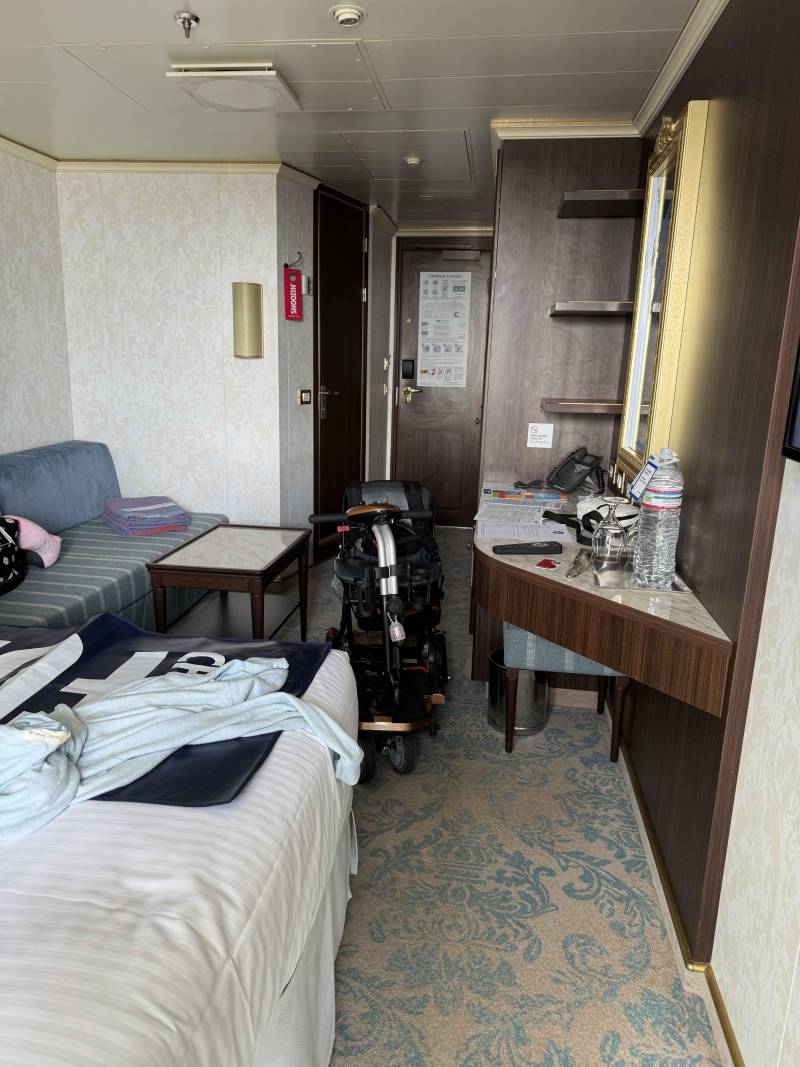
Stateroom
Speaking of the room, a big area of concern (and it’s a legit concern) is the stateroom for someone with a scooter. Carnival does offer different types of accessible staterooms.
- Fully Accessible Cabins (FAC): These staterooms are designed for use by guests with highly limited mobility or no mobility, who require the regular use of a wheelchair, scooter or other similar assistive devices. FAC contain accessible elements including turning space, accessible routes throughout the stateroom and an accessible bathroom. Additionally, the bathrooms contain grab bars and shower seats.
- Fully Accessible Cabins – Single Side Approach (FAC-SSA): These staterooms are designed for use by guests with highly limited or no mobility, who require the regular use of a wheelchair, scooter or other similar assistive devices. FAC–SSA are a type of FAC that provide an accessible route and clear floor space on only one side of the bed, in staterooms configured to provide only one bed. In a stateroom configured to provide two beds, the clear floor space will be between the beds, with one side of each bed getting an accessible route. Additionally, these staterooms have an accessible bathroom that contains grab bars and shower seats.
- Ambulatory Accessible Cabins (AAC): These staterooms are designed for use by guests with mobility limitations, who do not require the regular use of a wheelchair, scooter, or other similar assistive devices. For example, AAC are ideal for guests who only use an assistive device (like a cane or a walker) for traversing longer distances, and who may benefit from certain accessible features like grab bars, to assist with balance. Please keep in mind this type of stateroom has a step going into the bathroom and balcony (if applicable).
- Standard Cabins: These staterooms have an entry doorway measuring approximately 22" (55.9 cm), an 8" (20.3 cm) lip into the cabin bathroom, a 4" (10.2 cm) lip into the shower stall and a 7" (17.8 cm) lip to the balcony (if applicable).
Our stateroom was a standard cabin with a balcony (pictured above). For the sake of this article, I wanted to see how my scooter would fit in this style room. Plus we really wanted the balcony.
I can report that I was able to get my scooter through the door and into the room. Yes it was a tight fit, and yes I might’ve had to adjust my approach to get in and out of the room each time, but it was very little inconvenience.
I do think our next cruise we will try for a FAC as the small step up to get into the bathroom was a bit of a challenge (especially when the boat was swaying). Otherwise, each room can work for wheelchairs and scooters and not really eat up that much more space.
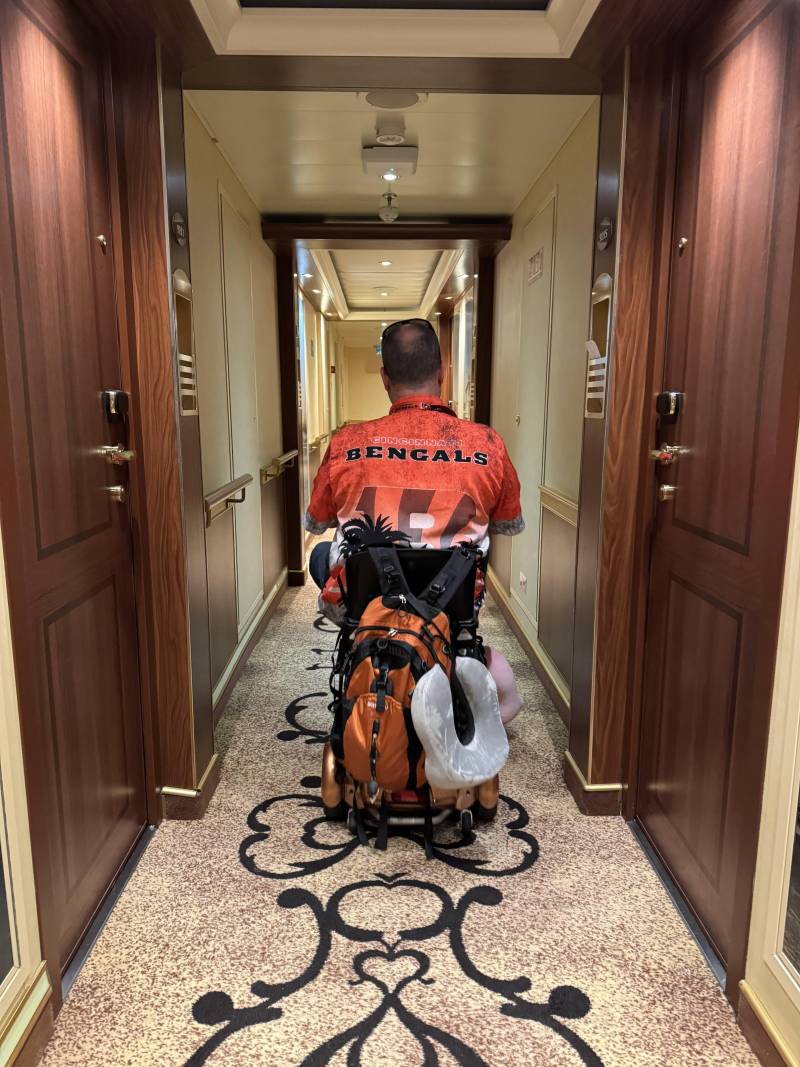
Getting Around the Ship
Narrow hallways, crowded elevators, confusing floorplans. Those are all things that even able-bodied people fret about on cruises. On the Venezia this was certainly the case too. Making my way through the hallways to get to my cabin was especially tight. When housekeeping had their carts in the hallway it was a very tight squeeze. But this proved to be nothing more than a minor inconvenience not an obstacle.
The elevators on the Venezia were different. Rather than push up or down, they have a programmable elevator where you press the number of people and the floor you want to go, then it tells you which elevator to go to.
In theory this is a great idea and here’s a tip if you have a wheelchair or a scooter: add one more person to your elevator call. For example, my wife and I would always punch in three people instead of two, to make room for the scooter.
The other pet peeve is how people crowd the elevator getting on and off. This is the case on every cruise ship I’ve been on. When you are backing off the elevator and you’re crowded by people who may be less than considerate or aware of their surroundings this can be a high-stress situation.
I’m happy to report I didn’t mash anyone’s toes or run into anyone. But it was close a couple times!
Throughout the ship there were handicap-accessible bathrooms. Doors automatically opened and closed with the push of one button. They were intended for single use. They were spacious with their own private sink too. For anyone in a scooter or wheelchair these were conveniently located on many of the floors and were certainly appreciated by me!
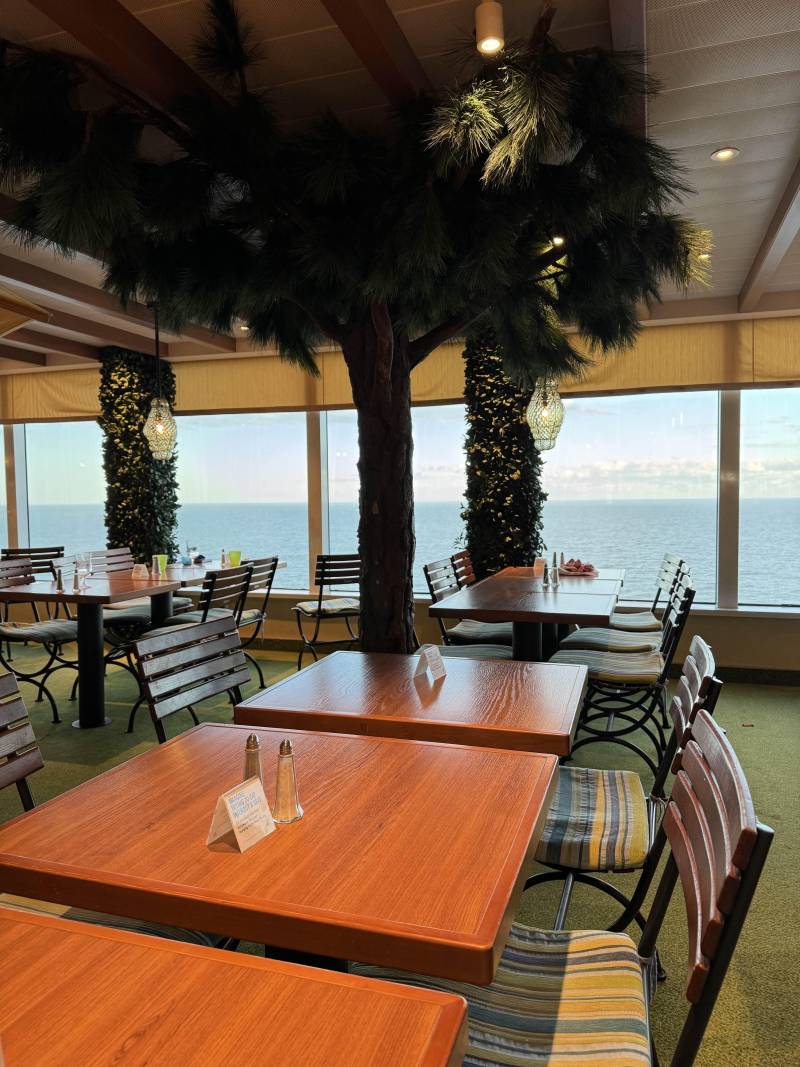
Dining
Cruise ships have many dining options, but in the evening, one of the pleasures is enjoying being served in the formal dining room. The Venezia’s dining room was pretty typical. Using my scooter to get to my table was easy. I would find a convenient and close place to park it near my table and walk to my table.
The 10th floor buffet dining area was more chaotic. Again narrow passageways, inconsiderate people and a lack of open seating caused the most angst for my trip. Kudos to members of the wait staff who offered to carry my plate around the buffet and to my table. They went out of their way to be accommodating in that manner, but it still couldn’t overcome the cramped quarters of the seats in that area.
I would recommend some kind of “accessible” designated area for those wanting to partake in the buffet (and who doesn’t want to partake in the buffet?).
Entertainment
The Carnival Venezia has a stunning and large theater with amazing and talented performances. They had handicap designated seats throughout the theater and I found that to be quite refreshing. I haven’t seen that on other cruise ships.
Additionally the pools on the Venezia had chair lifts for those who need assistance getting in and out of the pool. I even witnessed one of the workers testing it out to ensure that it worked. While I didn’t need such accommodation but it was nice to see this an option.
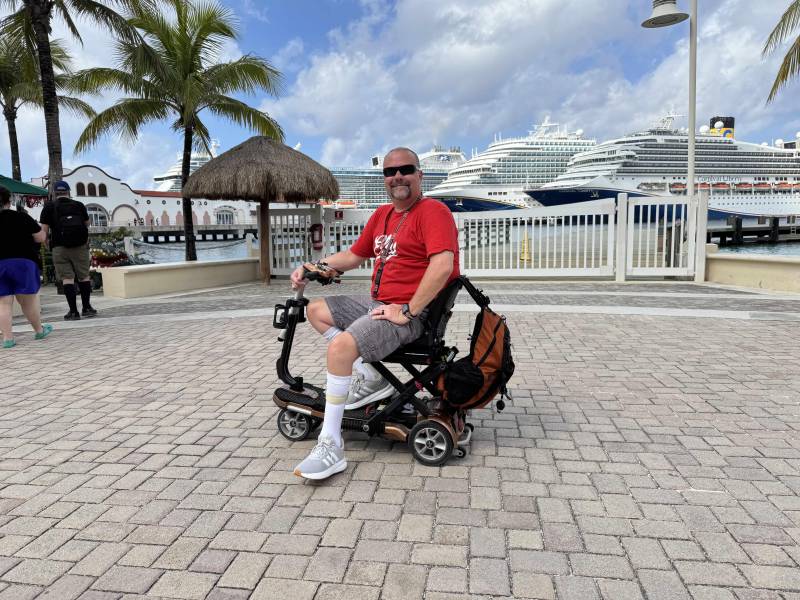
Excursions
The allure of exploring a new port is one of the main draws of a cruise. People with mobility issues should not be excluded in this process. On the Venezia we went to three ports: Roatan, Belize and Cozumel. In each port I was able to bring my scooter off the ship. I was concerned about Belize as this port requires the use of boat tenders, but I was pleasantly surprised to be able to drive my scooter right onto the tender. The staff on this boat were incredibly accommodating and went out of their way to assist me.
Each of our excursions were accommodating as well as we enjoyed a beach day in Roatan, a wildlife boat tour in Belize and then we just explored the beautiful port of Cozumel and did some shopping. There was no stress or worries for me in my scooter and that made each port stop enjoyable and memorable!
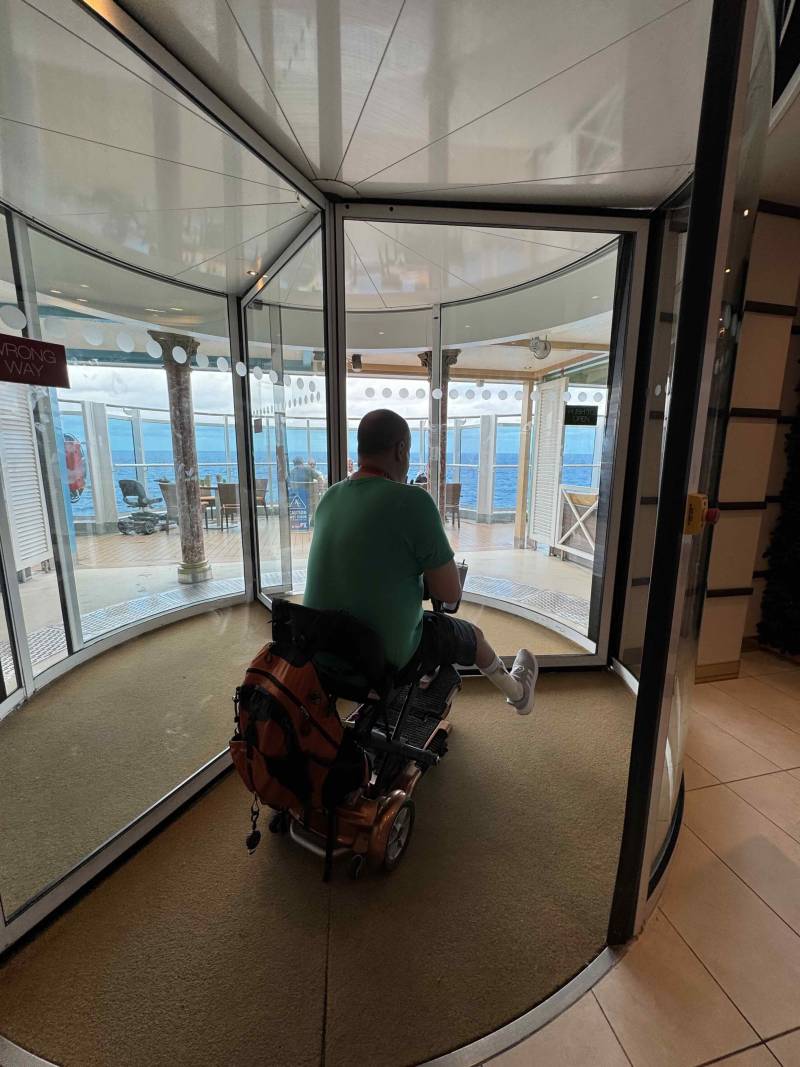
Debarkation Process
Getting off the boat is always a bummer. You don’t want your vacation to end. But all good things must come to an end. Similar to getting on the ship, debarkation was easy. Once again there was a line specific for scooters and wheelchairs and I was able to breeze through that line.
- Request "early debarkation" or VIP status when booking your cruise - this allows you to depart during less crowded times and gives you priority access to elevators and gangways. Most cruise lines offer this option either complimentary for guests with mobility needs or as an affordable add-on.
- Take advantage of the porter service available at most cruise terminals. For a small gratuity, porters can handle all your luggage while you focus on safely maneuvering your scooter through customs and immigration. They're familiar with mobility devices and can help ensure your scooter is properly handled during the transfer process.
- Book transportation ahead of time through the cruise line's accessible shuttle service rather than trying to find accessible transport at the port. These pre-arranged services ensure properly equipped vehicles with trained drivers who understand mobility device handling, plus they typically offer door-to-door service from the ship to your final destination.
Carnival provided transport to us from Port Canaveral back to the Orlando Airport. My scooter was stowed underneath with our luggage and was waiting for me when we pulled up to the airport. It doesn’t get any easier than that!
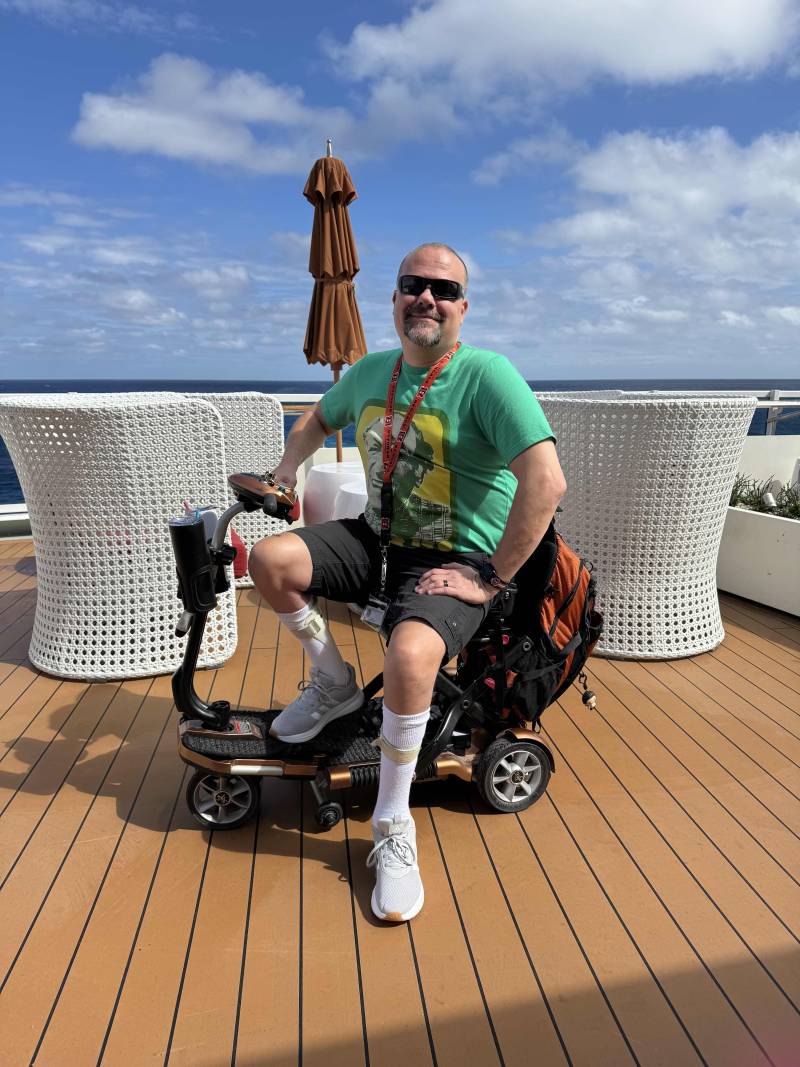
Mobility Scooters Make Cruising Even More Accessible
Each cruise that I’ve been on with my scooter I had a similar experience as to the one I’ve talked about here on the Venezia. However, hats off to Carnival because the staff of the Venezia were a little more accommodating, helpful, and friendly than those on Princess or Royal Caribbean ships that we've sailed on previously. However, all in all my experiences crusing with a mobility scooter have been enjoyable and the industry as a whole does a wonderful job of accommodating people with disabilities whether that's food intolerances or mobility challenges.
If you have mobility issues and you are worried about taking a cruise, don’t pass up the chance to make memories on any of these cruise ships. Each ship has a minimum level of what they have to provide, and most of the ships, including the Venezia, go way above the minimum.
The cruise industry's commitment to accessible travel makes it one of my favorite vacation options because it opens a world of possibilities for travelers with mobility needs. From cruising the glaciers of Alaska to rolling down the Malecon in Puerto Vallarta on a Mexican Riviera cruise, the cruise industry continues to be one of the leaders with regard to accessible travel and a great option for folks like me who depend on my mobility scooter to get around.
Additionally, working with a travel advisor such as Heather Hills from Flow Voyages makes the planning process even easier for those looking for extra assistance. As a trained Recreation Therapist whose father is in a wheelchair, she has extensive experience helping clients select the ideal ship and stateroom while providing guidance on port accessibility and excursion options too. The sea beckons to everyone, and with expert support, your mobility scooter becomes your passport to adventure!
